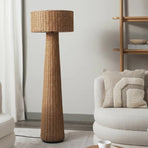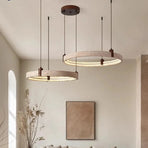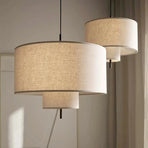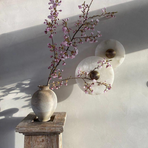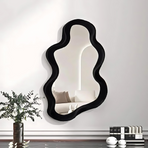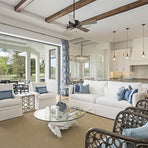There’s a reason beautifully designed homes dim the lights as evening falls.
It’s not just ambiance—it’s intentional. A well-placed pendant light slows the moment, softens the room, and draws people closer. Suspended above the dining table, it becomes more than a fixture. It becomes an atmosphere.
Forget function-first lighting. In a space built for connection, the pendant light is everything—anchor, sculpture, sensory cue. It doesn't just illuminate; it defines. The material, the glow, the shadow it casts—all of it shapes the way the room feels, and how people move through it.
And in homes where the dining table holds more than food—where it hosts slow mornings, spirited debates, last glasses of wine and first birthday cakes—the light above it matters deeply. The right fixture turns an everyday table into a moment. A statement. A place you want to stay.
This is why the pendant is no longer just a “finishing touch.” It’s a foundational design decision. In today’s interiors—especially across homes embracing open-plan living—it acts as a spatial anchor. The glow of a dining room pendant light distinguishes the dining zone from the rest, subtly creating intention in a layout without walls.
Whether you're working with a grand timber setting or a compact corner nook, choosing the right dining table pendant light means more than matching metals or mimicking trends. It's about scale. Mood. Movement. And when you get it right—when the light hangs at just the right height, in just the right tone—it quietly elevates everything around it.
Because in the end, it’s never just lighting. It’s the thing that makes the rest of the room make sense.
Looking to find that one piece that makes your space feel complete? Explore Elenorra’s curated collection of lighting—designed to anchor, soften, and elevate the everyday. From sculptural forms to minimalist silhouettes, each piece brings warmth, rhythm, and presence to the heart of your home.

Scale and Shape Matter
Start with the table. Not the fixture.
Because a well-placed dining table pendant light doesn’t just light a surface—it mirrors it. The shape, length, and posture of your table should guide what hangs above it. The relationship between the two is what creates visual rhythm. And in a space without walls, rhythm matters.
Round or square tables ask for centred glow. Something soft, sculptural, balanced. A single pendant—like our Jayne or Lucciola—brings cohesion to these forms without overpowering them. Their curves echo the tabletop below, creating a focal point that feels calm, grounded, and whole.
Rectangular tables have a different energy. They’re linear, directional. So their lighting should follow suit. A dome-shaped pendant like Ainsley—with its sculptural curve and polished finish—acts as a grounding visual anchor over longer tables.
Alternatively, multiple pendants, evenly spaced, can create a sense of rhythm. A trio of Dalarna lights adds movement and sculptural interest along the table’s length without overwhelming the space.
For something more minimalist, a single Ulima makes a bold, architectural statement—perfect for narrower tables or sleek, contemporary interiors.
Oval tables live somewhere in between. The rules relax slightly. Here, you can go centred with a single pendant or embrace asymmetry with uneven spacing or layered heights. Sculptural forms like Hjordis often shine here—they reflect the table’s organic nature without trying to mirror it too literally.
But whatever the table shape, the goal remains the same: balance. A pendant light over a dining table should feel like an extension of the table itself. Not competing, not shrinking. Just quietly holding space.
And when the form of the light mirrors the shape below? That’s when the dining zone begins to feel intentional. Designed. Not just filled in, but considered.

The Glow That Sets the Tone
Some lights brighten a space. Others change the way it feels.
That’s the quiet power of a well-chosen dining room pendant light—not just to illuminate, but to soften the room’s edges. To shift the mood. To shape the energy of a meal, a moment, a conversation.
This isn’t about wattage. It’s about glow.
The most atmospheric dining spaces don’t rely on harsh overhead lighting. They glow from within—warm, low, and consistent. That’s why bulb temperature matters. A modern pendant light for dining table use should sit comfortably in the warm white spectrum—ideally around 2700K to 3000K. Any cooler, and the space begins to feel sterile. Any warmer, and things veer into sepia-toned gloom.
Then there’s diffusion. Fixtures Jayne, with its frosted glass globe, scatter light gently—creating an even throw without hot spots. It’s the kind of light that flatters both the room and the people in it.
This is especially important in open-plan homes, where your pendant needs to distinguish the dining area without dominating it. You want definition, not drama.
Lights like Shizu deliver restraint without retreat—its natural finish and warm glow set the tone quietly and intentionally. Its muted profile, natural finish, and soft amber glow are less about spotlighting and more about setting the tone. The table becomes a destination. The room slows down.
And for evenings that need range—think weeknight dinners one moment, long conversations the next—dimmability is non-negotiable. Fixtures like Nancy or Stelo pair beautifully with dimmable bulbs, giving you the flexibility to modulate the space, not just light it.
Because the right pendant doesn’t just brighten a room. It deepens it.

Proportion, Placement, and the 70cm Rule
Even the most beautiful pendant light can feel off if it’s in the wrong place. Lighting isn’t just about what you hang—it’s about where you hang it.
When it comes to dining, there’s a golden rule that designers quietly swear by: 70 to 85 centimetres from the tabletop to the base of the pendant. It’s the sweet spot—close enough to create intimacy, high enough to allow clear sightlines across the table.
Too low, and the light becomes a barrier. Too high, and it loses its connection to the space below. The magic is in that floating zone—where the pendant hovers, holds, and invites.
This is especially true when styling hanging lights over dining tables in rooms with vaulted ceilings or open-plan layouts. The pendant acts as a visual anchor. It gives weight to the dining area. Without it, the table can feel adrift—like it was placed there, not designed into the room.
Scale matters just as much. A large pendant light over dining table settings—think Stelo or Rosemary—has presence. It makes the dining table feel grounded, important. These fixtures are bold without being brash, sculptural without being loud. They thrive in rooms with high ceilings, long tables, or dramatic proportions.
In smaller spaces, Ulima proves that lightness can still make a statement. Its organic silhouette floats effortlessly above the table, casting dynamic shadows without dominating the room. With its sculptural profile and woven delicacy, Ulima brings softness and rhythm—ideal for intimate dining nooks or homes that favour natural finishes and a gentler visual footprint.
And if your space straddles both? Adjustable fixtures give you flexibility without compromise. Because sometimes the light needs to adapt—just like the room does.
When placement, scale, and proportion align, the pendant stops looking like an accessory. It becomes architecture.

Layering Light for Depth
A pendant isn’t just a light source—but it shouldn’t be the only one, either.
The most inviting spaces are built on layers—timber on stone, linen over oak, soft shadows weaving through structure. And lighting is no exception. A well-placed dining table pendant light grounds the room, but it’s the supporting glow—floor lamps, wall sconces, or even candlelight—that brings the rest to life.
Think of the pendant as setting the mood—but the ambient lighting around it sets the pace. It lets the room breathe. It softens transitions—from slow breakfasts to spirited dinners, weeknight meals to weekend wine.
This is where sculptural pieces like Callista come in. With its sleek, minimalist discs and architectural suspension, Callista commands presence on its own. But it also plays well with others. Its linear silhouette makes it ideal for layered lighting plans—whether paired with accent lights on nearby walls or used in a series over a long table.
Callista’s form is intentional. It brings rhythm to open spaces and quietly mirrors modern materials—stone, marble, brushed brass. When placed alongside textural accents or dimmable side lights, it doesn’t compete. It complements. It elevates.
And that rhythm matters. Layered lighting isn’t just about aesthetics—it regulates how the room feels. When the only light source comes from above, the space can feel flat, even clinical. But when multiple lights—pendants, sconces, or architectural fixtures—work in harmony, the space feels more human. More alive.
In nervous system terms, it’s the difference between being seen and being held.
Because the best pendants over a dining table don’t just light the table—they invite the rest of the room to respond.
Materiality and Echo
Good lighting isn’t just about the light itself—it’s about the material that carries it.
In a well-designed space, every finish speaks. The timber of the dining table, the brushed metal of the chairs, the grain of the cabinetry, the curve of the ceramics. A pendant light is part of that conversation. And when it echoes—just slightly—what’s already happening in the room, everything starts to feel intentional.
This doesn’t mean matching. It means resonating. A brass fixture above a table with brass-accented legs. A ceramic pendant echoing a handmade bowl. A matte black fitting speaking quietly to your tapware or window frames.
Pieces like Nancy get this balance right—combining warm metallics with a soft form that doesn’t fight for attention, but still feels design-forward. Shizu, with its Japandi restraint and natural finishes, sits beautifully above dining settings layered in linen, ash, or stone. And Hjordis, with its suspended globes and minimal lines, adds lightness where timber furniture or darker palettes need contrast.
A dining room pendant light should feel like it belongs—not because it blends in, but because it picks up on something already in the room and carries it further. The material, the tone, even the shape—it should feel like a response, not an interruption.
This is especially true for dining table pendants that double as statement pieces. The bigger the pendant, the more it needs to earn its place. Not through extravagance—but through cohesion. Let it echo your textures. Let it hold the same visual temperature. Let it be part of the design’s rhythm.
Because when a light finishes the sentence the room has already started—it doesn’t just work. It sings.
Final Thoughts
The right pendant light doesn’t just light the room—it completes it.
It’s the detail that brings balance. The cue that marks the table as a place to gather, pause, and stay a little longer. Whether bold and sculptural or soft and restrained, a well-chosen pendant brings rhythm to the space it floats in—and intention to the moments that unfold beneath it.
Because the lighting isn’t background. It's a narrative. It’s the thing that connects the furniture to the atmosphere, the architecture to the experience.
And in a dining space designed for connection, a pendant doesn’t just illuminate. It says: this moment matters.
Frequently Asked Questions
-
What is the best pendant light for a dining table? The best dining table pendant light depends on your table shape and space. For round tables, a single centred pendant like Jayne or Lucciola creates a balanced focal point. For long tables, linear pendants like Ainsley or a trio of smaller pendants like Hjordis work beautifully to echo the table’s shape.
-
How high should a pendant light hang over a dining table? The ideal height is 70 to 85 cm from the tabletop to the bottom of the pendant. This creates enough intimacy without obstructing sightlines or conversation, especially important for pendants over dining tables in open-plan spaces.
-
Can I use more than one pendant light above my dining table? Absolutely. For larger or rectangular tables, using two or three evenly spaced pendants creates balance and rhythm. Consider using pendants like Ulima in a staggered trio for a softer, layered effect.
-
What kind of light bulb should I use in a dining room pendant light? For mood and comfort, use warm white bulbs in the 2700K–3000K range. These create a soft, flattering glow that enhances both the meal and the mood. Many dining room pendant lights work best with dimmable options for flexibility.
-
Can a pendant light define a dining area in an open-plan home? Yes—and beautifully so. A well-placed pendant light over a dining table acts as a visual anchor. It separates the dining zone from living or kitchen areas without needing physical barriers, making the space feel more defined and intentional.
Where can I buy designer pendant lights in Australia? Elenorra offers a curated collection of designer pendant lights made to elevate Australian homes—from sculptural centrepieces to minimal silhouettes. Each piece is selected for quality, materiality, and mood.
Browse Elenorra’s collection of pendant lights and chandeliers—where form meets glow.

